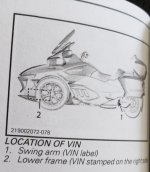IdahoMtnSpyder
Well-known member
As I understand it French is the legally required first language in Quebec which means all documentation must be prepared in French and then translated. It makes no difference the largest market base is English. Another issue I've seen is inconsistency in the the nomenclature of parts. Look for microswitch in the manual. You won't find it even though that is the universal English word for the switch for the frunk lid and the parking brake pulley.

